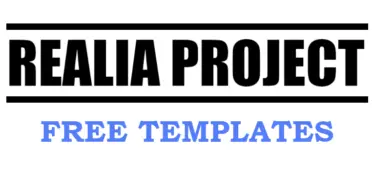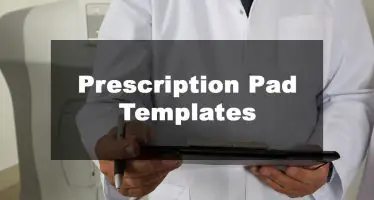Medicines are essential for treating any health issues. However, sometimes due to erroneous prescriptions, wrong medication may be bought and consumed by patients.
FDA states that it receives 100,000+ complaints every year related to medication errors. As per a report, 39% of these errors occur due to wrong drug prescriptions by health practitioners, and 23% account for the incorrect analysis of the doctor’s notes by pharmacies. This, in turn, leads to 7000-9000 deaths in the USA per year.
So, to prevent such incidents, a prescription pad must be created with a lot of care and attention. From unreadable handwriting to the accuracy of the prescribed medicines, a doctor’s pad should be clear, informative, and precise. To achieve this purpose, referring to a reliable prescription pad template is highly recommended.
Download Printable Prescription Pad Templates in Word & PDF
Experienced medical professionals create readymade prescription templates to help you avoid errors arising from manual work. These layouts are available in PDF and Word for patients, pharmacists, and practitioners. Since they are easy to edit and highly customizable, any of you can download them and use them per your requirement.
Blank Prescription Template Format
A blank prescription is a fill-in-the-blank medical document where the prescriber details and patient identifiers are written down comprehensively. A doctor can easily opt for such templates to authorize medicines in a more organized and discrete way for the convenience of the sufferers.
These layouts usually contain 3 sections. In one, there is the physician’s name, registration number, qualification, and contact details. In the other section, the patient’s name, physical attributes, contact information, recommended medicine, quantity, dosage instruction, and duration are specified. Beneath it, there’s also a space for the doctor’s signature and stamp.
The last section is only for the use of pharmacies to confirm the dispensing of the prescribed drug. It comprises the dispense date, location of the pharmacy, and the pharmacist who issued the said medicine.
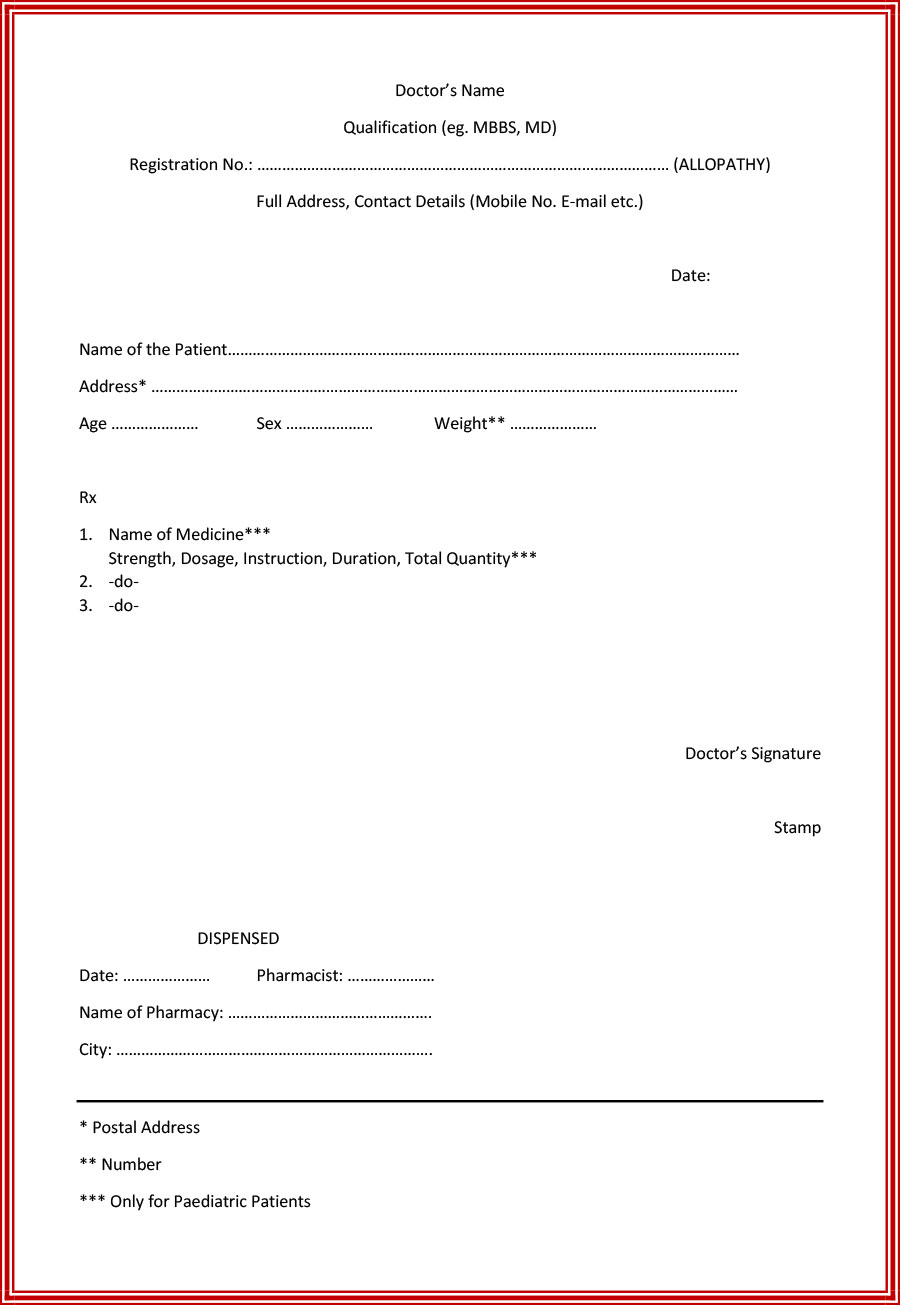
Viral Prescription Pads
These are used only for viral infection diagnosis and treatment. Physicians can prescribe antimicrobials and antiviral drugs on these documents and offer comprehensive guidance to patients on medication education.
Usually, these pads come in a checkbox format to avoid messy handwriting and effective prescription interpretation by the pharmacists and patients.
The templates have tabs by the side of some predefined diagnostic signs of a viral infection, general symptom relief, medications, and follow-up instructions. Based on your check-up, physicians tick the needful boxes, educating victims about their current medical conditions and how they should use antimicrobials correctly to recover soon.
Besides, these pads include generic details like the patient’s name, date of diagnosis, and doctor’s signature for legalization.
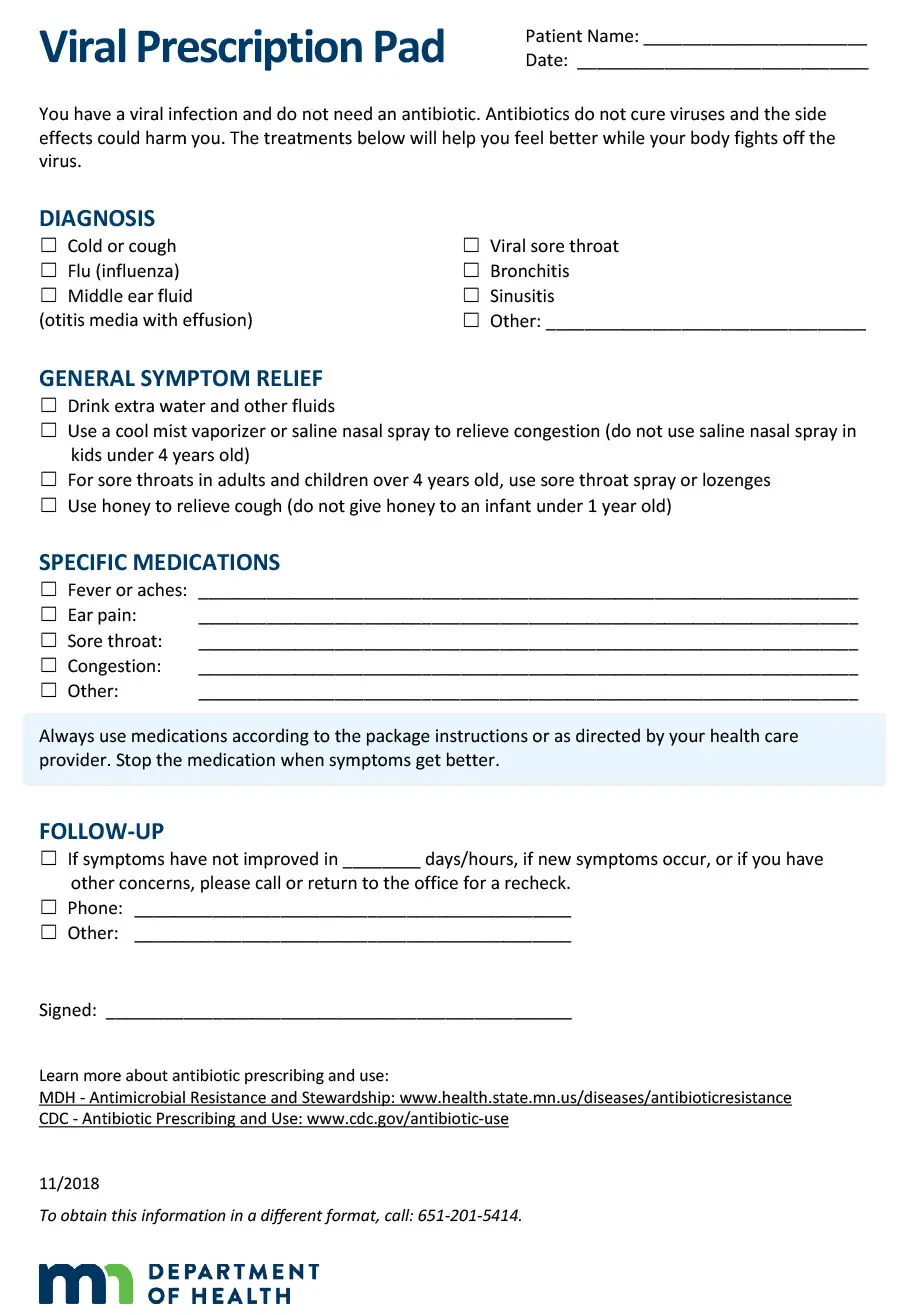
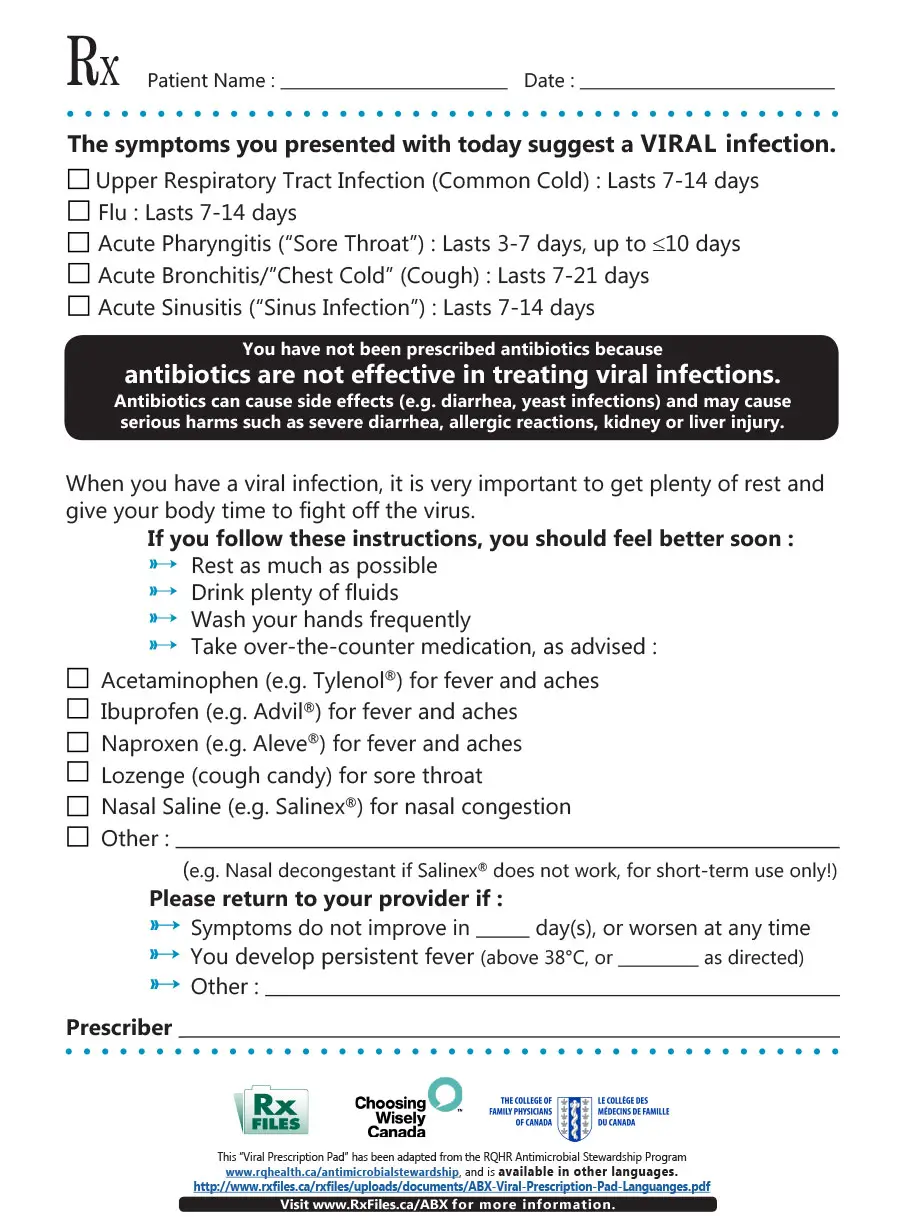
Over-the-Counter Medicine Prescription Template
People do not need a doctor’s note to buy over-the-counter (OTC) medicines like acetaminophen, dextromethorphan, ibuprofen, and loratadine to self-treat common health issues like body aches, fever, allergies, etc.
However, if any patient wants to get reimbursed through FSA (flexible spending account), they would need a prescription even for OTC drugs. In such a case, they can refer to this legally-approved readymade template.
It has a separate section for inputting the sufferer’s name, their registration number on the blue hospital card, date of birth, and contact details. It also contains the provider’s name, NPI number, date, and a space for the physician’s signature. But these details must be filled by the healthcare professional to validate the prescription in front of the federal law.
Moreover, this form includes an organized table with listed medication names, dosage instructions, strength, quantity, and consumption directions. Victims must fill in these details under the practitioner’s guidance or as per the drug labels to avoid intaking the wrong medicines.
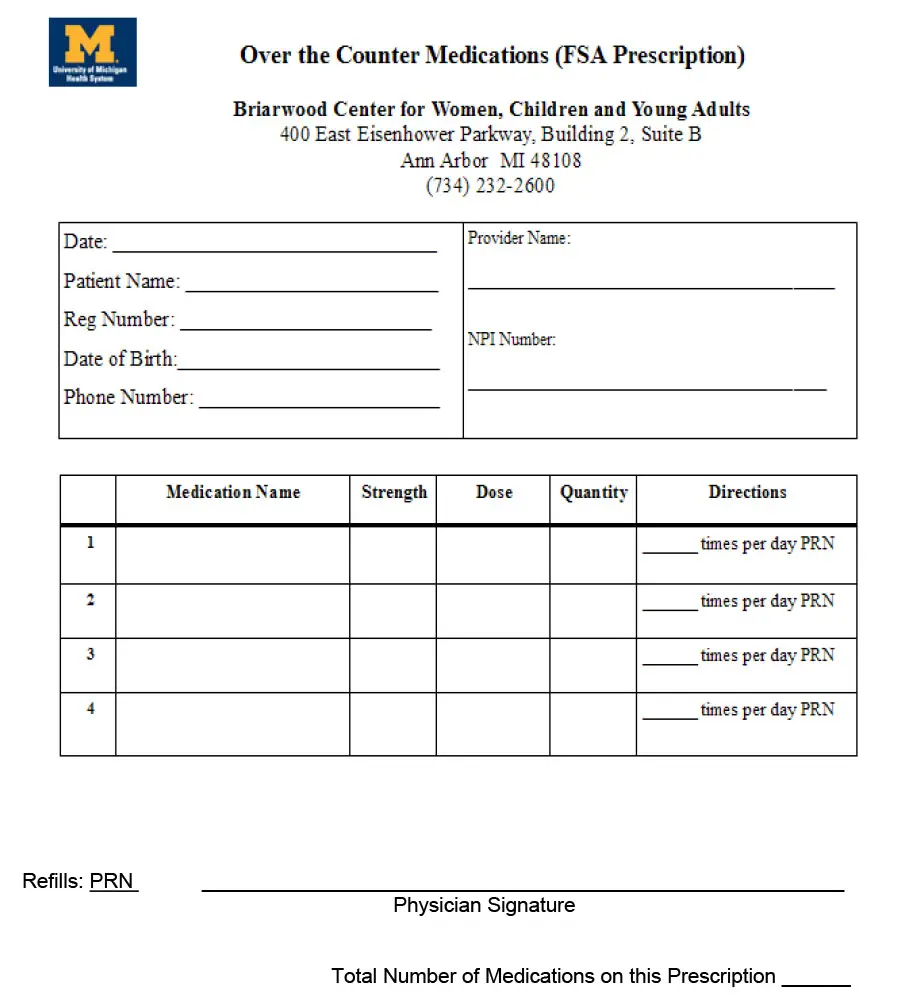
Ayurvedic and Unani Medicine Prescription Template
Since Ayurveda has a different approach to diagnosing and treating health ailments, writing instructions for the medicines is different too. Hence, Ayurvedic and Unani prescriptions have a proper segmented format regulated by the council under the code of ethics.
This template consists of 6 parts. One section includes the doctor’s complete information, including their full name, educational qualification, registration number, and contact details. It is followed by the sufferer’s attributes, including their full name, contact information, age, sex, identity marks, and Prakruti. These particulars are essential to document the prescription of the right ASU drugs.
The third part is the most crucial element of this layout, highlighting the detailed information about a prescribed drug in a table. It helps a patient understand the medicine better and its correct consumption. Here, the practitioner needs to provide the classical formulation’s name and mention whether it applies to Granthadhar or Rogadhikar.
Also, the drug’s dosage, form, frequency and time of administration, Anupan, and total quantity and duration of intake must be noted in the table. Beneath the table, the doctor should specify if a refill is needed so the patient can get drugs from a pharmacist showing the same note.
The following section includes instructions regarding the particular diet that a sufferer needs to follow during the administration of the ASU medicine. After that, a space for the physician’s signature is provided to authenticate the prescription.
Lastly, all details related to the pharmacy, such as the items dispensed, date, number of refills, and name and contact information of the dispensing vendor, are mentioned.
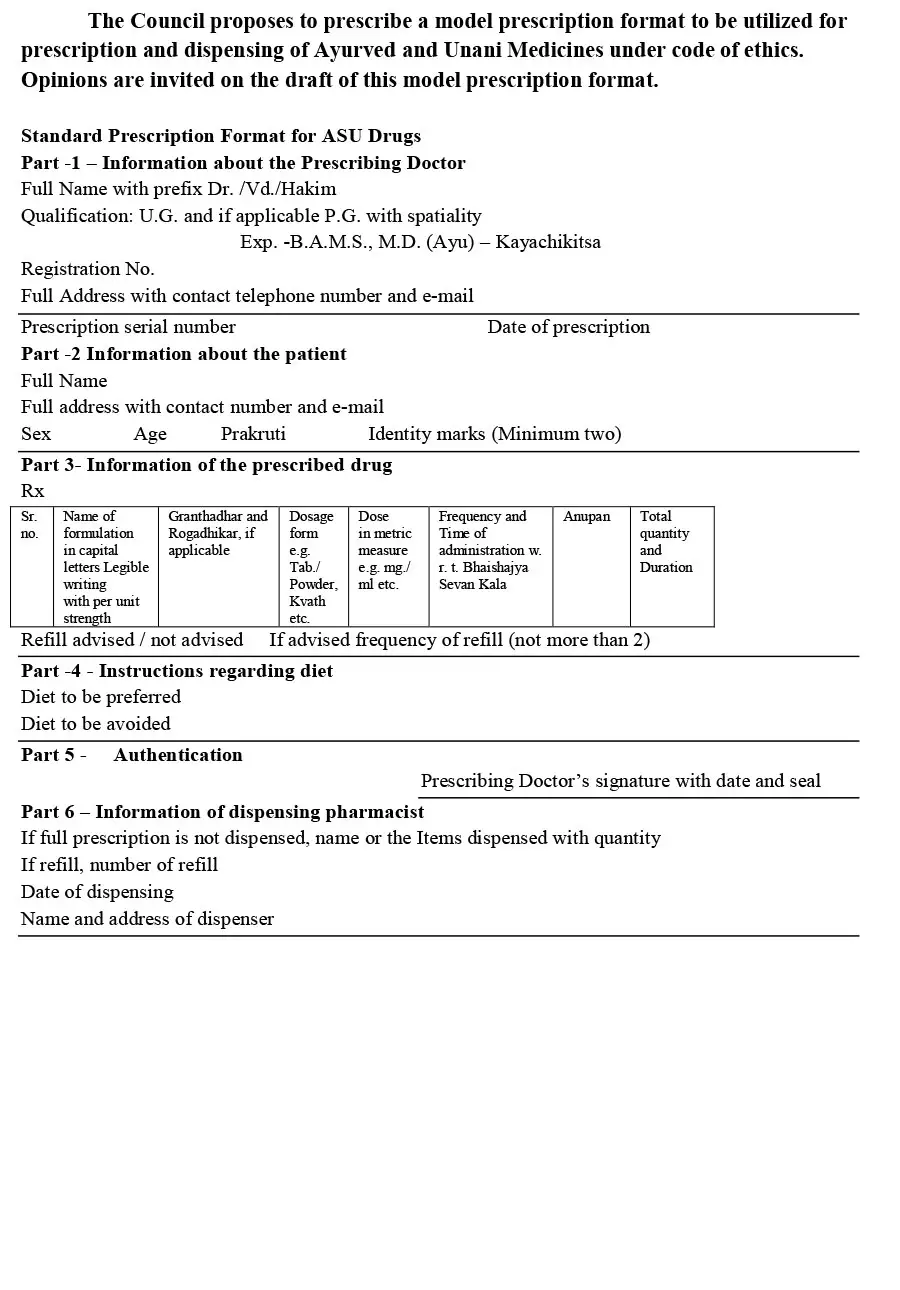
Counterfeit-Proof Prescription Pad Sample
A licensed healthcare practitioner should use a standardized counterfeit-proof prescription for authorizing controlled substances to patients. However, these blanks must be purchased only from Health Department-approved prescription vendors.
This template includes pre-printed doctor details, like their name, contact information, category of licensure, and DEA number, to validate their legality in recommending controlled substances. It also has a space for writing the victim’s information and date.
To prevent tampering and reproduction of the prescription, it comes in background color with special blue or green inks. Other security features are printed on the front or back of the pad. It also contains a unique tracking number of the print vendor on the front for safety concerns. Finally, the signature of the practitioner validates the note.
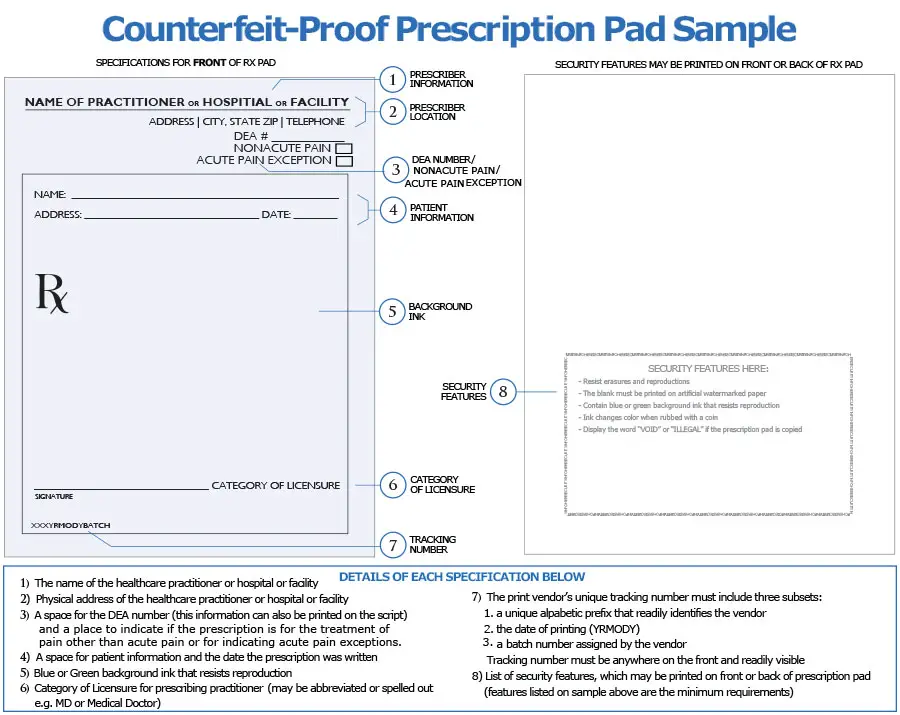
What is a Prescription Pad?
A prescription pad is a notepad used by a registered healthcare professional to keep records of a patient’s diagnosis, treatment, medication, and dosage instructions. The document is legalized and finalized only after the doctor’s signature.
Hence, it acts as a communication mode between clinicians and pharmacists where the former authorizes the latter to compound and dispense particular drugs to sufferers. Also, this note educates patients on taking the correct medication in the right way for their quick recovery.
Components
A standard prescription includes the following components.
- Prescriber Details: It must include relevant information about the healthcare practitioner, such as their clinic or hospital address, contact details, identifiers (NPI or DEA), prescription number, etc., which victims can use in emergencies.
- Date: As per law, regular prescriptions are valid for 180 days. Hence, the date lets pharmacists know when the medicines were first authorized and last dispensed if brought for refilling.
- Patient Details: The sufferer’s name and contact information must be mentioned in this legal, medical document. Also, their age, sex, and medical history are noted down by the practitioner for the correct prescription of medications and doses.
- Superscription: It is represented by the Latin term ℞, which implies, “you take.” It is used in a prescription to symbolize praying to the almighty for the patient’s quick recovery.
- Inscription: This component corresponds to the details of the advised medicaments. It includes the name and quantity of drugs to be dispensed or the name and strength of each ingredient to be formulated.
- Subscription: It contains the physician’s instruction to the pharmacist regarding the dosage form and number of doses for the authorized medicines.
- Signa: It is represented by the Latin term Sig. In this section, the prescriber states the usage direction of a particular drug for the patient’s convenience. The pharmacist should place these detailed instructions on the containers’ labels.
- Refills: Here, the doctor must specify the number of times the medicines need to be refilled by showing the same prescription to the pharmacist.
- Prescriber’s Signature: This component refers to the physician’s signature done in their own hands to authenticate this document.
Size
A prescription pad comes in three main sizes – A4, A5, and A6. It has a bounding so that the paper can be torn easily. It is usually rectangular and can be large or small-sized.
Benefits
The benefits of using or referring to a prescription are as follows:
- Enhanced Treatment: These documents allow clinicians to monitor the diagnosis and treatment of patients efficiently. Hence, it is time-saving for both doctors and victims. Also, it facilitates improved productivity, professionalism, and error minimization.
- Safety: Prescription pads allow physicians to keep a safe and secure medical record in one place, reducing the chances of medication errors.
- Better Organization: It eliminates the need for numerous examinations to be done in every check-up, which makes the treatment process simpler, time-saving, and affordable. Detailed documentation of a patient’s medical history can keep things organized for the doctor in the future.
- Effective Drug Dispensing: A well-written prescription enables pharmacists to comprehend medications properly and issue the correct ones with the right dosage to people. Thus, it prevents illness or death due to wrong medicines.
- Proper Medicine Consumption: A readable doctor’s note allows patients to consume medications optimally and correctly, avoiding overdosage issues.
How to Read a Prescription?
It’s crucial to decipher a prescription for both pharmacists and patients. On one side, it prevents pharmacies from dispensing the wrong medicines. On the contrary, interpreting the physician’s note can help you get better insights into your treatment and medication.
So, here’s how one should read a doctor’s prescription correctly.
- It includes the clinician’s identification numbers, which are evidence of their government-approved license in medical practice.
- Some Latin and English combined medical terminologies or abbreviations can be used in a prescription. If you cannot understand it, ask them to simplify those terms so that you can read and follow them appropriately.
- Here are some abbreviations that are commonly seen in a clinician’s note.
- q.t.t. means drops (for any drops)
- OS means in the left eye (for eye drops)
- OD means in the right eye (for eye drops)
- OU means in both eyes (for eye drops)
- Subq means subcutaneous (for injection)
- IM means intramuscularly (for injection)
- IV means intravenous (for injection)
- Check the drug’s amount carefully. The quantities are usually mentioned as follows.
- Milliliters (for liquid medicine or medicine by syringe)
- Milligrams (for powder)
- Integer numbers or fractions (for capsules or pills)
- Sometimes you may come across the alphabet “T” on your physician’s note with some dots on its top. The number of dots corresponds to the number of tablets to be taken.
- Look into the dosage and usage instructions. Some of the following notations correspond to dosage information.
- PO means orally
- QD means once a day
- BID means 2 times a day
- QOD means alternate days
- Q4H means every 4 hours
- QHS means before going to bed
- PRN means as needed
- p.c. means after having a meal
- a.c. means before having a meal
You can always ask the healthcare professional to interpret these terms for better understanding.
Pharmacists must go through the prescribed drugs’ generic or brand names, quantities, and dosages in the template to dispense the correct medicine with proper labels attached to it to the patients.
If a dispensing vendor cannot understand the doctor’s handwriting, it’s better to contact the physician directly to clarify doubts.
Medication Errors
Errors may occur while prescribing, documenting, transcribing, dispensing, and administering medicines. It primarily happens due to the wrong diagnoses of health practitioners, poor conditions of drug storage in pharmacies, and incorrect usage of drugs by patients.
- Errors by Physician: Not checking the victim’s medical history and drug allergies while diagnosis may lead to the recommendation of wrong medicines, insufficient dosage, or incorrect frequency of administration. Besides, have many job responsibilities in a hospital, such as examining patients, attending meetings, etc. While performing these tasks, they are asked to write drug orders in haste, making prescriptions illegible and erroneous.
- Errors by Pharmacist: Most pharmacists make an error in deciphering the doctor’s note, leading to dispensing the wrong drugs. They also make mistakes in compounding ingredients in the correct dose, quantity, and strength. Due to poor drug storage conditions in inventories or vendors’ inattentiveness, they sell expired or unsealed drugs, resulting in critical medication errors.
- Errors by Patient: A patient is as much responsible as a healthcare practitioner or pharmacist for making medication errors. During a check-up at the clinic or hospital, miscommunication between a patient and doctor can lead to improper diagnosis of their medical conditions, leading to wrong drug prescription. Besides, if unable to understand the note, people should ask the physician and/or pharmacist about the dosage and usage instructions for proper consumption of drugs at home.
Types
Here’s a list of the common medication errors made by practitioners, pharmacists, or patients.
- General Prescription Errors
- Messy handwriting
- Incomplete patient details
- Inaccurate medication
- Omission
- Not complying with the standard protocols of prescribing drugs
- Administration Errors
- Wrong rate
- Extra dosage
- Wrong route
- Incorrect frequency
- Wrong duration
- Knowledge-Based Errors
- Drug knowledge dissemination
- Failing to learn about the victim’s medicinal allergy or drug interactions
- Erroneous therapy alteration
- Inadequate medication education in patients
- Action-Based Errors
- Selling deteriorated or expired drugs due to poor storage
- Incorrect dose compounding by pharmacists
How to Prevent Them?
Being a bit more careful on everyone’s end is the best way to do away with medication errors. However, referring to an approved prescription pad template helps avoid general mistakes to a large extent by maintaining enhanced accuracy.
In addition, cross-checking, double-checking, and verifying the doctor’s note are the protocols that can be followed to prevent large-scale medication errors. One can implement this process by adopting the following ways.
- Verifying sufferer’s drug allergies
- Noting down patient-specific identifiers
- Maintaining proper documentation and compiling
- Facilitating drug awareness and educating patients
- Using checklists and automated reminders by pharmacists
- Using barcodes
- Setting up a computerized prescribing system
Conclusion
Prevention of medication errors, efficient drug administration, and proper diagnoses and treatment – a prescription pad template can help you in all. It not only saves the doctor’s time by organizing all patient details comprehensively in one place but also helps sufferers and pharmacists read and follow the note better with less likeability of facing messy handwriting issues.
References & Sources:
